Geotimes

Untitled Document

Travels in Geology
October 2005
On Darwin's trail
Michael Roberts
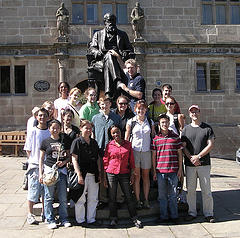 It
was a perfect English summer's day as I drove from Lancaster to Shrewsbury in
England to meet students from Harvard University on their summer school course
on the life and work of Charles Darwin. The students were based in Jesus College
at Oxford University, and were visiting Darwin localities in Cambridge, London
and, of course, Darwin's country home "Down House." I was to show
them where Darwin went on his geological trip around Wales with geologist Adam
Sedgwick in 1831, just before setting sail on the Beagle — Darwin's
famed five-year voyage around the world that led to The Origin of Species
— but it's a trip anyone can follow.
It
was a perfect English summer's day as I drove from Lancaster to Shrewsbury in
England to meet students from Harvard University on their summer school course
on the life and work of Charles Darwin. The students were based in Jesus College
at Oxford University, and were visiting Darwin localities in Cambridge, London
and, of course, Darwin's country home "Down House." I was to show
them where Darwin went on his geological trip around Wales with geologist Adam
Sedgwick in 1831, just before setting sail on the Beagle — Darwin's
famed five-year voyage around the world that led to The Origin of Species
— but it's a trip anyone can follow.
Harvard students pose in front of a statue
of Charles Darwin in Shrewsbury, England, where Darwin was born. Over three
days, the students followed Darwin's path in the mid-19th century on a geological
tour of North Wales. All photos by Andrew Berry, taken on the summer field trip.
The route followed by Darwin in 1831 goes through some of the most beautiful
parts of Wales. The nearest airport is Manchester in England, but the route
begins only six hours' drive from London. It is essential to rent a car or,
if energetic, a bicycle! To re-trace all of Darwin's steps, you need to be a
good hiker, and competent with map and compass if you tackle the higher mountains.
There are many hotels, bed and breakfasts or campsites where you can stay. You
will need the Ordnance Survey maps of the area and the Geological Map of Wales.
The best time to visit Wales is between May and September. The trip can be combined
with visiting some of the finest of Welsh and English castles. As my American
friends say, you will visit places no American goes to!
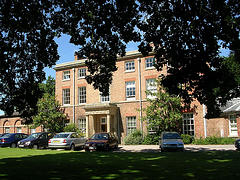 Day 1
Day 1
Our first stop on Darwin's trail was Shrewsbury, where Darwin was born and his
family home and school are located. There's
hardly a trace of Darwin at the home, a fine Georgian house now used as a tax
office, but a statue erected in 1897 stands in front of his old school, built
in 1600.
Charles Darwin's family home, named "The
Mount," in Shrewsbury bears no trace of him.
After dinner in the Field Studies Centre (a country estate that offers outdoor
studies in biology, geology and other sciences), near Shrewsbury, we hiked up
Nesscliffe Hill, a quintessential English hill that Darwin incorrectly identified
on his first attempt at geological mapping in July 1831. We compared his geological
descriptions with actual outcrops and looked over to Llanymynech Hill, the scene
of another of Darwin's early geological field trips, providing us a tantalizing
taste of what was to come. After watching the sun set from atop Nesscliffe,
we moved on to a Darwinian pub, the Queen's Head, for a pint. It was a good
end to our first day following Darwin.
Day 2
After breakfast, we piled into the bus and set off up the A5, which was Thomas
Telford's magnificent London-to-Holyhead coach road. Telford was one of the
great civil engineers of the early 19th century. Robert Darwin's (Charles' father)
investment in the road was allegedly the source of funding for Charles' voyage
on the Beagle. For the next two days, we were to follow the route Darwin
took with Sedgwick in August 1831. Sedgwick had come to Wales to work out the
ancient strata below the Old Red Sandstone, later known as the Devonian, and
took Darwin as a field assistant at the suggestion of Darwin's mentor, John
Stevens Henslow.
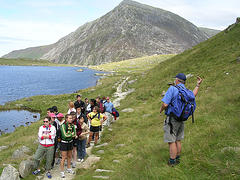 Pretty
soon, we crossed the border into Wales, where our first stop was to visit a
monument in Chirk Church to Fanny Mostyn Owen, Darwin's first love before he
left to attend college at the University of Cambridge. They corresponded during
the Beagle voyage and occasionally after that, though Darwin married
his cousin Emma Wedgwood not long after he returned from his voyage.
Pretty
soon, we crossed the border into Wales, where our first stop was to visit a
monument in Chirk Church to Fanny Mostyn Owen, Darwin's first love before he
left to attend college at the University of Cambridge. They corresponded during
the Beagle voyage and occasionally after that, though Darwin married
his cousin Emma Wedgwood not long after he returned from his voyage.
Michael Roberts explains the glacial
geology of this Welsh valley to Harvard University students. This scenery was
about the same as what Charles Darwin examined 174 years ago.
A few miles away, the town of Llangollen beckoned us, with the ruins of Castell
Dinas Bran, a 13th-century Welsh castle, looming above, and the Carboniferous
limestone cliffs of Eglwyseg Mountain beyond. Darwin and Sedgwick ascended Eglwyseg
Mountain on Aug. 6, 1831, trying to find a conformable sequence from the limestone
through the Old Red Sandstone into the older strata below. Sedgwick was determined
to find the Old Red Sandstone and would spend the next few days trying to follow
its trail.
There was no Old Red Sandstone on Eglwyseg, so off they went on Aug. 7 (as did
we, 174 years and 2 days later) over the Horseshoe Pass into the Vale of Clwyd,
a broad valley bounded by hills, containing the little towns of Ruthin, Denbigh
and St. Asaph. The few outcrops there were also not of Old Red Sandstone. We
pressed on, passing by the hills where Darwin did a 50-kilometer traverse on
foot and marked his findings on Sedgwick's map. Sadly we had no time to stop
either to look at the details of the geology, especially the Ogof caves where
Darwin and Sedgwick found a rhinoceros tooth, or at the towns.
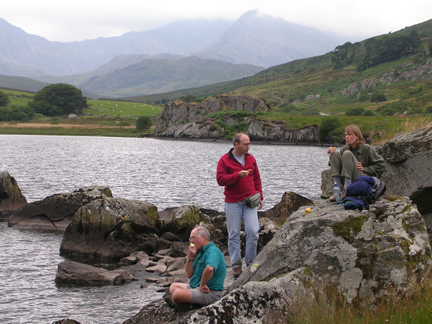 If you
have more time, stop at some charming Welsh spots in this area for a nice respite.
The Great Orme is one of the neatest coastal sites in North Wales, full of fossils
and Neolithic artifacts; Conwy Bridge and Castle, erected in the 13th century,
are pretty; Aber Falls offers good hiking; and Telford's picturesque Britannia
Bridge will take you across the Menai Strait into Anglesey, a beautiful island
with several quaint Welsh villages and castle ruins.
If you
have more time, stop at some charming Welsh spots in this area for a nice respite.
The Great Orme is one of the neatest coastal sites in North Wales, full of fossils
and Neolithic artifacts; Conwy Bridge and Castle, erected in the 13th century,
are pretty; Aber Falls offers good hiking; and Telford's picturesque Britannia
Bridge will take you across the Menai Strait into Anglesey, a beautiful island
with several quaint Welsh villages and castle ruins.
Charles Darwin first explored the Snowdonia
mountains in North Wales in 1831, but failed to notice the glacial geology —
moraines, a glacial lake, cirque valleys — that can be seen throughout
this popular hiking area.
Shortly after midday, we arrived at Llyn (lake) Ogwen in the heart of Snowdonia.
We could see all the glaciated scenery that Darwin did not notice in 1831 but
did notice during another visit in 1842. We immediately set off into Cwm Idwal,
a magnificent glacial valley that is both Darwin's and my favorite place. Darwin
visited it several times prior to 1831 and again in 1842, during his last trip
to the mountains. The path to the lake in the heart of the valley weaved through
ice-scoured Ordovician volcanic rocks, which Darwin thought were altered slate
or basalt, but he didn't have Roadside Geology to guide him! Darwin was
a geology novice attempting to understand complex Paleozoic geology with no
previous work to help him.
After eating our lunch and admiring the scenery with hanging valleys and corries
all around, we looked at Darwin's notes from 1831 and 1842 to see how he understood
the geology. In 1831, Darwin missed a syncline named Devil's Kitchen, thinking
it was a volcanic plug. Sedgwick put him right in a letter a few weeks later,
but by then Darwin was thinking of the long ocean voyage ahead of him. We hiked
up the steep slopes by Devil's Kitchen (a botanist's paradise), and quickly
passed the limit of Darwin's exertions in 1842, when illness had already weakened
him at the age of 33. Above Devil's Kitchen we could see much of the geology
of Snowdonia laid bare by glacial action. We returned the way we came, marveling
at the scenery, the geology and Darwin's perception.
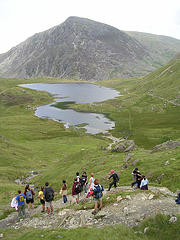 Day
3
Day
3
Another fine day dawned, and we retraced Darwin's last mountain walk of 1842,
ploughing though bracken and stinging nettle to find the limits of the Nant
Peris glacier, just below Snowdon itself. We had lunch on the rocks by Lynnau
Mymbyr, a stone's throw from Plas y Brenin, the old coaching inn at Capel Curig
where Darwin stayed many a time. We had fine views of Snowdon peak looking larger
than its 1,085 meters. To the south, we could see Moel Siabod, a mountain that
Darwin climbed in 1831, making geological notes as he went. We looked longingly,
but we had no time to climb the mountains.
The Nant Peris glacier sits just below
Snowdon peak in North Wales. In 1842, when Darwin returned to this site after
his voyage around the world on the Beagle, at the age of 33, he could
no longer hike these hills, as his health was already failing him.
We did not have time to follow Darwin's 65-kilometer route south from Capel
Curig to Barmouth, which took him two long days. In his autobiography, Darwin
claimed that he "went in a straight line by map and compass across the
mountains to Barmouth." However, I explained to the students that this
was not a physical possibility because of the terrain. In fact, Darwin traveled
in an s-shaped squiggle, following an ancient road, the Sarn Helen, then a "drovers'
road" (used in the past for driving sheep), ultimately to the coastal resort
of Barmouth, where he stayed for a few days with university friends before heading
back to Shrewsbury. There, a letter awaited him inviting him on the Beagle.
After lunch near Snowdon, we headed back to Oxford following the same coach
road to Shrewsbury that Darwin followed 174 years ago. Thus ended our three-day
journey with Darwin in Wales, which took Darwin many weeks over many years —
and even more time for me to unravel from his notebooks and correspondence.
Michael Roberts studied geology
at Oxford and was an exploration geologist in Africa for several years before
becoming an Anglican clergyman, and is now vicar of parishes south of Lancaster.
He is a member of the History of Geology Group of the Geological Society. For
more information or a list of references, email: michael.andrea.r@ukonline.co.uk.
Links:
Darwin
Country
North
Wales Tourism
Shrewsbury
Tourism
Travels in Geology
Back to top
Untitled Document

 It
was a perfect English summer's day as I drove from Lancaster to Shrewsbury in
England to meet students from Harvard University on their summer school course
on the life and work of Charles Darwin. The students were based in Jesus College
at Oxford University, and were visiting Darwin localities in Cambridge, London
and, of course, Darwin's country home "Down House." I was to show
them where Darwin went on his geological trip around Wales with geologist Adam
Sedgwick in 1831, just before setting sail on the Beagle — Darwin's
famed five-year voyage around the world that led to The Origin of Species
— but it's a trip anyone can follow.
It
was a perfect English summer's day as I drove from Lancaster to Shrewsbury in
England to meet students from Harvard University on their summer school course
on the life and work of Charles Darwin. The students were based in Jesus College
at Oxford University, and were visiting Darwin localities in Cambridge, London
and, of course, Darwin's country home "Down House." I was to show
them where Darwin went on his geological trip around Wales with geologist Adam
Sedgwick in 1831, just before setting sail on the Beagle — Darwin's
famed five-year voyage around the world that led to The Origin of Species
— but it's a trip anyone can follow.
 Day 1
Day 1
 Pretty
soon, we crossed the border into Wales, where our first stop was to visit a
monument in Chirk Church to Fanny Mostyn Owen, Darwin's first love before he
left to attend college at the University of Cambridge. They corresponded during
the Beagle voyage and occasionally after that, though Darwin married
his cousin Emma Wedgwood not long after he returned from his voyage.
Pretty
soon, we crossed the border into Wales, where our first stop was to visit a
monument in Chirk Church to Fanny Mostyn Owen, Darwin's first love before he
left to attend college at the University of Cambridge. They corresponded during
the Beagle voyage and occasionally after that, though Darwin married
his cousin Emma Wedgwood not long after he returned from his voyage.  If you
have more time, stop at some charming Welsh spots in this area for a nice respite.
The Great Orme is one of the neatest coastal sites in North Wales, full of fossils
and Neolithic artifacts; Conwy Bridge and Castle, erected in the 13th century,
are pretty; Aber Falls offers good hiking; and Telford's picturesque Britannia
Bridge will take you across the Menai Strait into Anglesey, a beautiful island
with several quaint Welsh villages and castle ruins.
If you
have more time, stop at some charming Welsh spots in this area for a nice respite.
The Great Orme is one of the neatest coastal sites in North Wales, full of fossils
and Neolithic artifacts; Conwy Bridge and Castle, erected in the 13th century,
are pretty; Aber Falls offers good hiking; and Telford's picturesque Britannia
Bridge will take you across the Menai Strait into Anglesey, a beautiful island
with several quaint Welsh villages and castle ruins.  Day
3
Day
3